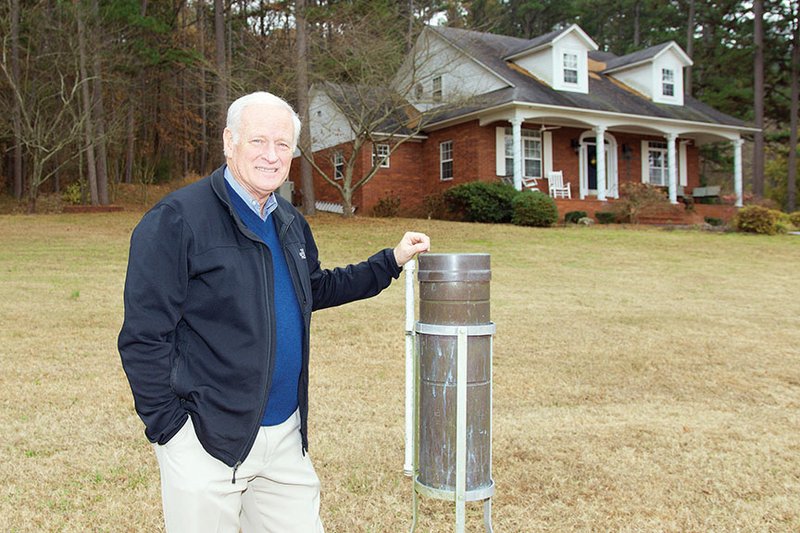Danville Mayor Phil Moudy is the rain man.
After there is precipitation, Moudy walks to the gauge stationed in his front yard to record the measurement, just as his parents and grandparents did before him at their homes.
The National Weather Service in North Little Rock has counted on the Moudy family to report rainfall since 1945. Phil and his wife, Mary Ann, have been reporting since 1995.
“It seems like I’ve been doing it forever,” Phil Moudy said. “It’s highly unusual for one family to do it so long.”
Moudy is part of the National Weather Service’s Cooperative Weather Observer Program.
Sean Clarke, observation-program leader, said it is “pretty rare” for one family to participate so long. He said that of the 120 volunteer observers in the “central-diamond” area represented by the North Little Rock office, the person with the second-longest tenure started in 1951.
Moudy, 68, said the job first belonged to his grandparents, Atley and Addie Mae Moudy. He doesn’t know how that started, but he’s heard the stories. The same 2-foot-tall, brass rain gauge that he uses was stationed in his grandparents’ and parents’ front yards. He said he has a photo of himself as a 4-year-old standing on the base of the gauge.
His grandfather would call the National Weather Service office to report the rainfall in Danville. In 1947, when the Blue Mountain Dam was completed, the couple also reported the water level of the Petit Jean River in Danville to the U.S. Army Corps of Engineers, Phil said.
“My grandmother would go down, park the car and climb over the bridge railing. Somebody saw her doing that once and called the police and said, ‘There’s someone trying to jump off the bridge,’” Phil said, laughing.
On June 1, 1964, Atley turned the rainfall reporting over to his son and daughter-in-law, J.A. and Ellen Moudy — Phil’s parents. Ellen wrote in a summary of the family’s relationship with the National Weather Service that when Atley retired, he received a big card of best wishes signed by 25 telephone operators who had talked to him over the years.
When J.A. died, Ellen gathered the information for another eight to 10 years, Phil said, for a total of about 30 years between both of his parents.
In 1995, after Phil retired from his 21-year service as an Air Force pilot, Mary Ann and he took over the family tradition of recording the rainfall.
Phil said he emails the National Weather Service with the results.
“It’s quite simple,” he said.
Clarke said volunteers used to mail a form once a week, which transitioned to phone calls and now emails.
Some of the volunteer weather observers measure just rainfall, like Phil, and others measure temperature, evaporation or soil temperatures.
Clarke said the goal is to have one volunteer in each county, but some counties have more than one observer.
He said Danville was chosen because the Petit Jean River runs through it.
The rainfall data collected supports the office’s hydrology program and helps with river forecasting, Clarke said, adding that river readings are now automated.
It’s helpful to have the consistency of the same family collecting weather-related information, he said.
“When we put these weather stations in, we want them to stay in the same place to get a long climate record,” Clarke said.
The co-op was formally created in 1890 under the Organic Act, according to the National Weather Service website, and more than 8,700 volunteers nationwide are in the program.
Clarke said volunteers are recruited in several ways, from advertising to knocking on doors.
Moudy said people love to talk to him about the weather.
“They’ll come up to me — ‘How much rain did we get last week?’”
He always knows. “We’re way down. We’re over 10 inches below normal in this area,” he said.
A few facts of his: the average rainfall in Danville, 50.3 inches; the largest annual rainfall was in 2015 — 74.59 inches. The least rainfall? That was 1963, when a mere 30.97 inches was recorded. A deluge came in 1982 when 10.97 inches was recorded in 24 hours. The largest monthly rainfall was 21.13 inches in October 1984.
He said he isn’t sure how long his family’s streak of recording the rainfall will go.
“My kids all live in Russellville, … but who knows?” he said.
Senior writer Tammy Keith can be reached at (501) 327-0370 or tkeith@arkansasonline.com.
